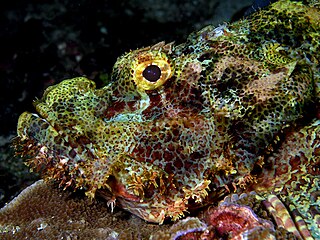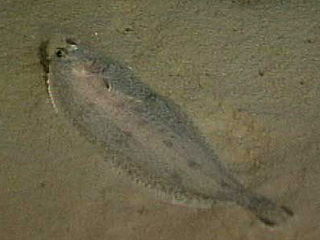
The Scorpaenidae are a family of mostly marine fish that includes many of the world's most venomous species. As their name suggests, scorpionfish have a type of "sting" in the form of sharp spines coated with venomous mucus. The family is a large one, with hundreds of members. They are widespread in tropical and temperate seas but mostly found in the Indo-Pacific. They should not be confused with the cabezones, of the genus Scorpaenichthys, which belong to a separate, though related, family, Cottidae.

The European sprat, also known as brisling, brisling sardine, bristling, garvie, garvock, Russian sardine, russlet, skipper or whitebait, is a species of small marine fish in the herring family Clupeidae. Found in European, West Asian and North African waters, it has silver grey scales and white-grey flesh. Specific seas in which the species occurs include the Irish Sea, Black Sea, Baltic Sea and Sea of the Hebrides. The fish is the subject of fisheries, particularly in Scandinavia, and is made into fish meal, as well as being used for human consumption. When used for food it can be canned, salted, breaded, fried, boiled, grilled, baked, deep fried, marinated, broiled, and smoked.

The lane snapper, the Mexican snapper, redtail snapper or spot snapper, is a species of marine ray-finned fish, a snapper belonging to the family Lutjanidae. It is native to the western Atlantic Ocean.

Acanthurus achilles, the Achilles tang, redtail surgeonfish or redspot surgeonfish, is a marine ray-finned fish belonging to the family Acanthuridae, the surgeonfishes, unicornfishes and tangs. This fish is found in the Pacific Ocean.

Bairdiella chrysoura, the American silver perch, silver croaker or goldtail croaker, is a species of marine ray-finned fish belonging to the family Sciaenidae, the drums and croakers. This species is widespread along the eastern cost of North America and is commonly caught by inshore anglers in search of larger species. This fish is common up to 20 cm (7.9 in), but can be found uncommonly to 30 cm (12 in).

The witch, known in English by a variety of other common names including the witch flounder, pole flounder, craig fluke, Torbay sole, and grey sole, is a species of flatfish from the family Pleuronectidae. It occurs on both sides of the North Atlantic Ocean on muddy sea beds in quite deep water. In northern Europe it has some importance in fisheries as a food fish.

Epinephelus flavocaeruleus, commonly called blue-and-yellow grouper, is a species of marine ray-finned fish, a grouper from the subfamily Epinephelinae which is part of the family Serranidae, which also includes the anthias and sea basses. It is associated with reefs in the Indian Ocean.

Cynoglossus is a genus of fish in the family Cynoglossidae. Most species are indigenous to the Indo-Pacific region, but there are also a few in warmer parts of the East Atlantic. They are commonly found in shallow waters on a muddy or sandy bottom, including estuaries and a few species are restricted to fresh water. One species Cynoglossus sinusarabici has invaded the Mediterranean Sea through the Suez Canal from the Red Sea, a process known as Lessepsian or Erythrean migration.
Cynoglossus abbreviatus, commonly known as the three-lined tongue sole, is a species of tonguefish. It is indigenous to the coast of the South China Sea, commonly found in shallow muddy or sandy waters along the coast of China, Taiwan, Korea and Japan.
Cynoglossus acaudatus, commonly known as the Natal tongue fish is a species of tonguefish. It is commonly found in shallow muddy or sandy waters along the coast of the Western Indian Ocean, Somalia down to South Africa, including Seychelles.

Cynoglossus arel, commonly known as the largescale tonguesole, is a species of tonguefish. The eyed side of the fish is uniform brown, with a dark patch on the gill cover, and its blind side is white. They are harmless to humans and predominantly feed on bottom-living invertebrates.
Cynoglossus browni, commonly known as the Nigerian tonguesole is a species of tonguefish. It is commonly found in the eastern Atlantic Ocean off the coast of west Africa, from Senegal to Angola. It is found on soft substrates such as mud or sand between depths of 15m and 40 m. Its main food is small benthic invertebrates.

Cynoglossus canariensis, commonly known as the Canary tonguesole is a species of tonguefish. It is commonly found in the eastern Atlantic Ocean off western Africa, from Mauritania and Western Sahara south to Angola, including the Canary Islands and Cape Verde Islands. It is a demersal species found at depths of 10-300m, it has been found in brackish water, but is normally a coastal species which occurs over substrates of sand or mud. It feeds on small fish and crustaceans. This species is targeted in trawl fisheries throughout its range and in many areas, it appears to have undergone significant declines. For example, in Gabon the mixed Cynoglossus stock is considered overexploited, while in other parts of western Africa such as Mauritania the stocks of Cynoglossus had declined by over 60% in the five or six years up to 2015. The IUCN list C. canariensis as Near Threatened due to is dependence on conservation.

Cynoglossus capensis, commonly known as the sand tonguesole, is a species of tonguefish.

Cynoglossus feldmanni, commonly known as the River tonguesole is a species of tonguefish occurring in freshwater. It is commonly found in Thailand, Laos, Borneo, Sumatra and Cambodia. It occurs in rivers in freshwater well above the tidal zone where it lives on the bottom feeding on benthic invertebrates.

Stegastes leucostictus is a species of damselfish found near the sea bed in shallow waters on the western fringes of the Atlantic Ocean. It is commonly known as the beau gregory or beaugregory.

Decapterus russelli, also known as the Indian scad, northern mackerel scad, round scad, Russell's mackerel scad, slender scad, or three lined grunter, is a species of ray-finned fish in the family Carangidae. It naturally occurs in the Indian and the western Pacific Oceans and has colonised the eastern Mediterranean through the Suez Canal. It is an important species in coastal fisheries throughout its range.

Monacanthus ciliatus, commonly known as the fringed filefish, the cuckold or the leather-fish, is a species of bony fish commonly found in shallow water in the western Atlantic Ocean, the Caribbean Sea and the Gulf of Mexico.

Drepane longimana, commonly known as the concertina fishbarred sicklefish or banded sicklefish, is a fish native to the Indo-Pacific and northern Australia.
Cynoglossus sinusarabici, the Red Sea tonguesole, is a species of tonguefish which occurs in the Red Sea and is now common in the eastern Mediterranean Sea following its migration through the Suez Canal. It was first recorded in the Mediterranean Sea off Israel in 1953 and successively observed in Turkey and Egypt. It has an elongated body with a rounded snout which has a rostral hook large, narrowly separated eyes. It has 99–101 dorsal fin rays, 78–79 rays in its anal fin and 8 rays in the caudal fin. The lateral line has 54–60 scales with 11 scales between the lateral line and the base of the dorsal fin. The lateral line is only present on the eyed side. It is uniform brown on the eyed side and whitish on the blind side. It grows to about 15 cm standard length.
















